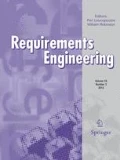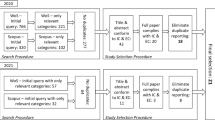Abstract
Users’ requirements of an information system are modeled in the analysis phase of the development process. The requirements can be modeled with various modeling methods. In this study, we compare two alternative methods for modeling the functional requirements: one is the UML Use Case (UC) model; the other is OO-DFD transaction (Object-Oriented DFD is a variant of DFD that includes data classes rather than “traditional” data stores). Each of these modeling methods consists of diagrams accompanied with narrative, semi-structured descriptions explaining their details. We conducted a controlled experiment that compared the comprehension of the two models (i.e., the diagrams and their descriptions) of a certain system and the quality of models created for a certain system with each of the two modeling methods. The main results of the experiment are that models created with the UC method are of better quality than models created with the OO-DFD transaction method because the former are simpler and less detailed; creating highly detailed models are error prone. Interestingly, in spite of the difference in the level of detail and structure, the experiment reveals no significant difference in comprehension of models of the two methods. The results call for improvement of the modeling methods in a way that considers the advantages of each of them, and thus we propose an improved method sketch that we call Enhanced Use Case, which will be evaluated in future work.




Similar content being viewed by others
Notes
In the Comprehension task we face a potential bias since the researchers created the models. This problem is well known since in many other experimental studies the researchers create the modeling tasks. Our work was done honestly and we created the "best" possible models with each of the methods, with no bias (as can be proved by the results of the comprehension task in next sections).
Because of the criticality of this grading, we decided to use two experienced graders for each solution. They were graduate students of Information Systems Engineering who served as TAs of the two involved courses (IS Analysis & Design, and OO Analysis & Design).
We cannot use Kappa's coefficient since it is suitable only for qualitative/categorical items; grades on a 0–100 scale are not categorical.
References
Arlow J, Neustadt I (2001) UML and the unified process: practical object oriented analysis & design. Addison Wesley, Reading
Bajaj A (2004) The effect of the number of concepts on the readability of schemas: an empirical study with data models. Working Paper, University of Tulsa, OK, USA
Bass L, Bergey J, Clements P, Merson P, Ozkaya I, Sangwan R (2006). A comparison of requirements specification methods from a software architecture perspective. Technical report, Software Engineering Institute, Carnegie Mellon
Booch G (1991) Object-oriented design with applications. Benjamin/Cummings, Menlo Park, CA
Booch G, Rumbaugh J, Jacobson I (1996) The unified modeling language for object-oriented development. Rational Software Corporation
Burton-Jones A, Weber R, Wand Y (2009) Guidelines for empirical evaluations of conceptual modeling grammars. J Assoc Inf Syst 10:495–532
Coad P, Yourdon E (1991). Object oriented analysis, 2nd edn. Prentice Hall, Englewood Cliffs, NJ
Cockburn A (2001) Writing effective use cases. Addison-Wesley, Boston
Cox K, Phalp K, Shepperd M (2001) Comparing use case writing guidelines. In: Proceedings of the 7th international workshop on requirements engineering: foundation for software quality, pp 101–112
DeMarco (1978) Structured Analysis and System Specification. Yourdon Press, New York
Dori D, Goodman M (1996) From object-process analysis to object-process design. Ann Softw Eng 2:25–50
Gane C, Sarson T (1979) Structured system analysis: tools and techniques. Prentice Hall, Englewood Cliffs, NJ
Gemino A, Wand Y (2003) Evaluating modeling techniques based on models of learning. Commun ACM 46:79–84
Hadar I, Kuflik T, Perini A, Reinhartz-Berger I, Ricca F, Susi A (2010) An empirical study of requirements model understanding: use case vs. tropos models. SAC’10 March, Sierre, Switzerland, pp 22–26
Hahn J, Kim J (1999) Why are some diagrams easier to work with? Effects of diagrammatic representation on the cognitive integration process of systems analysis and design. ACM Trans Comput Hum Interact 6(3):181–213
Jacobson I (1987) Object oriented development in an industrial environment. In: Proceeding of the object-oriented programming systems, languages and applications, pp 183–191
Jacobson I (1992) Object oriented software engineering: a use case driven approach. Addison-Wesley Professional, Reading
Jeyayaj A, Sauter VL (2007) An empirical investigation of the effectiveness of system modeling and verification tools. Commun ACM 50(6):63–76
Kabeli J, Shoval P (2005) Comprehension and quality of analysis specifications—a comparison of FOOM and OPM methodologies. Inf Softw Technol 47(4):271–290
Kim J, Hahn J, Hahn H (2000) How do we understand system with (so) many diagrams? Cognitive integration processes in diagrammatic reasoning. Inf Syst Res 11(3):284–303
Larman C (2002) Applying UML and patterns: an introduction to object-oriented analysis and design, and the unified process, 2nd edn. Prentice Hall, Englewood Cliffs, NJ
Mathiassen L, Munk-Madsen A, Nielsen P, Stage J (2000) Object oriented analysis and design. Marko Publishing, Alborg
Millet I, Nelson R (2007) Data flow diagram vs. use cases—student perceptions. Internatl J Inf Commun Technol Educ 3(1):70–78
Moody D (2006) What makes a good diagram? Improving the cognitive effectiveness of diagrams in is development. In: Proceedings of the 15th international conference in information systems development (ISD)
Parsons J, Cole L (2005) What do the pictures mean? Guidelines for experimental evaluation of representation fidelity in diagrammatical conceptual modeling techniques. Data Knowl Eng 55:327–342
Peleg M, Dori D (2000) The model multiplicity problem: experimenting with real-time specification methods. IEEE Trans Softw Eng 6:1–18
Ramsin R, Paige R (2008) Process-centered review of object oriented software development methodologies. ACM Comput Surv 40(1):3–89
Rockwell S, Bajaj A (2005) COGEVAL: applying cognitive theories to evaluate conceptual models. Adv Top Database Res 4:255–282
Rumbaugh J, Blaha M, Premerlani W, Eddy F, Lorensen W (1991) Object-oriented modeling and design. Prentice-Hall, Englewood Cliffs, NJ
Shoval P (1988) ADISSA: architectural design of information systems based on structured analysis. Inf Syst 13(2):193–210
Shoval P (2007) Functional and object-oriented analysis and design: an integrated methodology. Idea (IGI) Publishers, Hershey
Shoval P, Kabeli J (2001) FOOM: functional- and object-oriented analysis & design of information systems—an integrated methodology. J Database Manag 12(1):15–25
Siau K (2004) Informational and computational equivalence in comparing information modeling methods. J Database Manag 15:73–86
Topi H, Ramesh V (2002) Human factors research on data modeling: a review of prior research, an extended framework and future research directions. J Database Manag 13(2):3–19
White SA (2004) Introduction to BPMN, IBM Corporation, business process trends
Wohlin C, Runeson P, Höst M, Ohlsson MC, Regnell B, Wesslen A (2000) Experimentation in software engineering: an introduction. Kluwer, Boston
Yu E (1997) Towards modeling and reasoning support for early-phase requirements engineering. In: 3rd IEEE international symposium on requirements engineering, Annapolis, USA, pp 226–235
Author information
Authors and Affiliations
Corresponding author
Rights and permissions
About this article
Cite this article
Dahan, M., Shoval, P. & Sturm, A. Comparing the impact of the OO-DFD and the Use Case methods for modeling functional requirements on comprehension and quality of models: a controlled experiment. Requirements Eng 19, 27–43 (2014). https://doi.org/10.1007/s00766-012-0155-2
Received:
Accepted:
Published:
Issue Date:
DOI: https://doi.org/10.1007/s00766-012-0155-2




